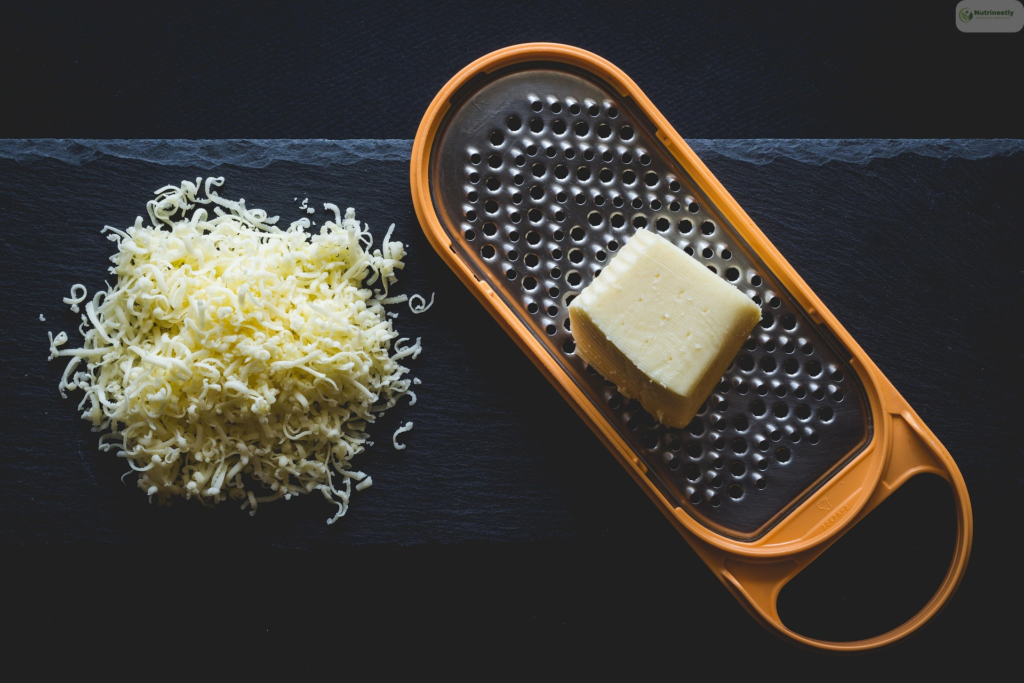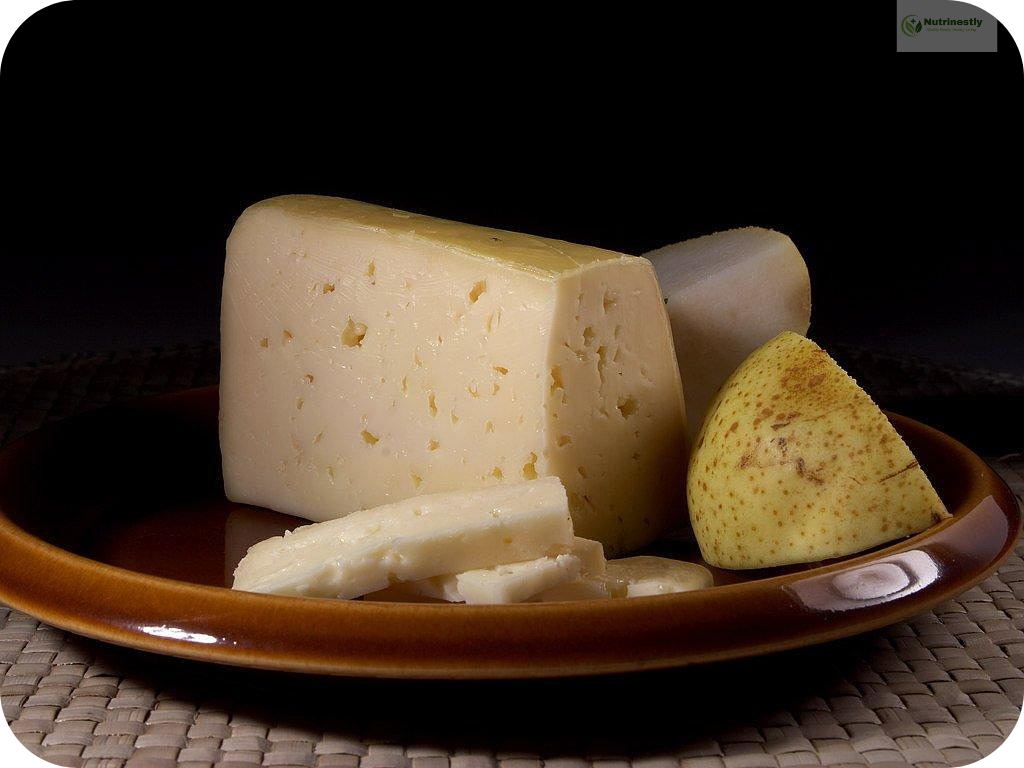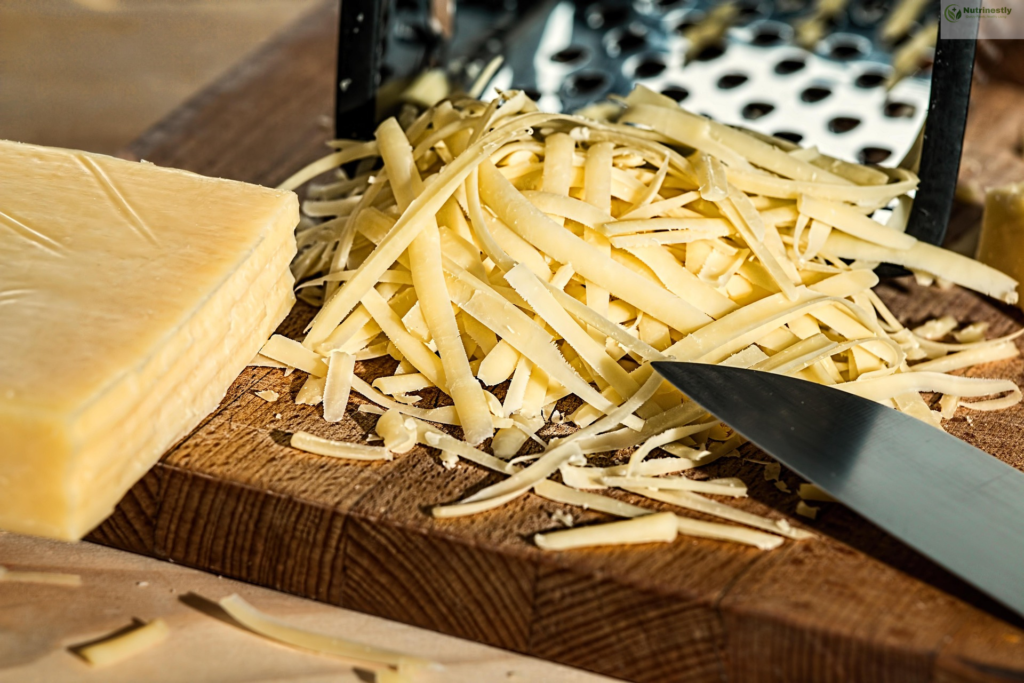I Introduction to Fat-Free Cheese

A. Definition and Overview
Let’s get real: cheese is one of those foods that looks almost too good to be true. Creamy, rich, and indulgent, it’s typically the crowning jewel of most dishes. But imagine being able to have all that cheesy delight without the fat. Enter fat-free cheese – a delicious alternative designed to satisfy our cheese cravings without compromising on healthier eating goals.
Fat-free cheese is usually produced by removing the milk fat from the cheese production. Fat-free cheese is produced from skim milk or milk substitutes instead of whole milk conventionally employed. The outcome? Significantly less fat and calories, yet still the spirit of cheese.
It is also worth pointing out that owing to contemporary food technology, fat-free cheese these days is flavored better than it ever has been. Owing to more recent advances in dairy technology and ingredient technology, food processors now have the ability to replicate the mouthfeel, melt, and texture of traditional cheese with essentially zero fat.
B. Popularity and Market Growth
As more and more people turn to healthier ways of living, demand for healthy alternatives has soared. The health food industry, once a specialist market, is now swamped with great new products – and fat-free cheese is among the giants.
Indeed, the international market for low-fat and fat-free cheese has continued on a consistent upward trend over the past decade. Consumers are seeking foods that aid in weight control, cardiovascular health, and general well-being. It comfortably fills this niche here, and it attracts athletes, health-food parents, and even chefs who want to get creative.
Chart: Growth of Fat-Free Cheese Market (2015–2025)
| Year | Market Size (Billion USD) |
| 2015 | 5.3 |
| 2017 | 6.1 |
| 2019 | 7.2 |
| 2021 | 8.4 |
| 2023 | 9.7 |
| 2025 | 11.0(Projected) |
This exponential growth is driven not only by health trends but also by a desire for convenient, low-guilt food options.
II. Nutritional Advantages of Fat-Free Cheese
A. Caloric Value and Weight Control
One of the strongest reasons why it is attractive to consumers is that it contains fewer calories. The following is a comparison:
Table: Calorie and Fat Comparison (Per 1 oz Serving)
| Cheese Type | Calories | Total Fat |
| Regular Cheddar Cheese | 113 | 9g |
| Part-Skim Mozzarella | 72 | 4.5g |
| Fat-Free Cheddar Cheese | 45-50 | 0g |
That’s a massive difference – almost 60% fewer calories! That makes fat-free cheese a great choice for anyone who is dieting to lose weight or who just wants to maintain their calorie intake in check.
For people on structured diets such as Weight Watchers, low-carb diets, or calorie-controlled diets, It is usually a favorite. It allows you the pleasure of cheese without ruining your plans.
Infographic Idea: Benefits of Fat-Free Cheese for Weight Watchers
- Zero to Low Points
- Flexible with Portion Control
- Slates Cravings
- Combines with Veggies & Lean Proteins
B. High-Protein Choices
Fat-free does not equate to protein-free. Many fat-free cheeses provide 7-9 grams of protein per ounce. And that’s wonderful news for
Keeping muscles: Especially excellent for those going to the gym or playing competitive sports.
Satiety: Protein foods are more satiating, reducing cravings.
Metabolism: Protein requires more energy to digest, raising calorie burn by a small amount.
Chart: Protein Content in Cheese Types (Per 1 oz)
Regular Cheddar | ██████████ 7g
Part-Skim Mozzarella | ███████████ 7.5g
Fat-Free Cheese | ████████████ 8g
That’s significant enough to be a satisfying component of your post-workout meal or a healthy midday snack.
C. Calcium and Nutrients
Calcium, naturally, is necessary for sound bones, teeth, and nerve function. The best news? Fat-free cheese doesn’t cut calories at the expense of calcium content. One ounce provides 15-20% of your daily nutrient allowance.
Besides calcium, it occasionally includes other nutrients such as:
- Vitamin D (in fortified types)
- Vitamin B12
- Phosphorus
- Selenium
These nutrients are critical for bone density, immune function, and even mental clarity. So while you’re enjoying fewer calories, you’re still nourishing your body.
III. Culinary Uses of Fat-Free Cheese
A. Versatility in Recipes
Fat-free cheese isn’t just for sandwiches (though it rocks there too!). This healthy ingredient shines in countless dishes:
- Salads: Crumble feta-style fat-free cheese over mixed greens.
- Pizzas: Sprinkle shredded mozzarella-style fat-free cheese on your homemade crust.
- Pasta: Mix into hot whole-wheat pasta for a creamy, low-cal twist.
- Omelettes: Season without the fat.
- Grilled cheese: Combine with whole grain bread for a guilt-free treat.

Need inspiration? Try it in:
- Zucchini lasagna
- Cauliflower crust pizzas
- Stuffed bell peppers
- Healthy mac and cheese
Table: Cooking Ideas for Fat-Free Cheese
| Dish | Cheese Type | Cooking Tip |
| Egg Muffins | Shredded Cheddar | Mix into batter for added crunch |
| Quesadillas | Fat-Free Mexican Blend | Pair with salsa and beans |
| Veggie Wraps | Fat-Free Swiss Slices | Crunch up with fresh cucumbers |
| Broccoli Casserole | Mozzarella Shreds | Slowly melt to prevent clumping |
B. Pairing Suggestions
Just like its full-fat cousins, fat-free cheese is enhanced by the right pairings. Use these pairings to enhance the flavor experience:
Fruits: apples, pears, grapes, and figs
Nuts: almonds and walnuts (in moderation)
Crackers: whole grain or low-sodium
Wines: light white wines such as Sauvignon Blanc or Pinot Grigio
Pro tip: It has less flavor. Spice it up with fresh spices, herbs, or a balsamic drizzle.
IV. Comparing Fat-Free Cheese Brands
A. Overview of Popular Brands
Let’s take a bite out of some popular brands in the fat-free cheese industry:
Table: Top Fat-Free Cheese Brands Review
| Brand | Type | Flavor Rating | Texture Rating | Best Use |
| Kraft Fat-Free Singles | American-style slices | ★★★★☆ | ★★★★☆ | Sandwiches, burgers |
| Lucerne | Mozzarella shreds | ★★★☆☆ | ★★★☆☆ | Pizza, baked dishes |
| Borden | American cheese slices | ★★★★☆ | ★★★★☆ | Melts well in hot dishes |
| Great Value | Mixed varieties | ★★★☆☆ | ★★☆☆☆ | Budget-friendly meals |
B. Ingredient Analysis
Most fat-free cheeses include a blend of:
- Skim milk or milk protein concentrate
- Enzymes
- Calcium chloride
- Carrageenan or xanthan gum (for texture)
- Preservatives like sorbic acid
While these ingredients are considered safe, it’s good to be informed. Some purists prefer natural, minimally processed options. Always check the label if you’re trying to avoid certain additives or are following a clean-eating plan.
V. Conclusion and Future of Fat-Free Cheese
A. Summary of Key Points
To wrap it all up:
It provides a lower-calorie, lower-fat version of traditional cheeses.
It’s nutritious and high in protein and nutrients such as calcium, which makes it a health-conscious eater’s wise choice.It can be used to cook with, snack on, and creatively combine.
Some brands offer great-tasting, readily available choices.
Whether weight loss, reduction of saturated fat, or simply trying healthier options, it belongs in your refrigerator.

B. Future Trends
The future of its looks good. Here’s what’s on the horizon:
Plant-based, fat-free cheese blends
Enhanced textures and flavor by technology-augmented fermentation
- Cleaner label and more organic
- Increased international market presence
Consumers are becoming smarter about ingredients and taste. With progressing food science, so will our cheese – and fat-free cheese, poised to stay popular as a health-conscious favorite.
So, have you tried fat-free cheese yet? What do you enjoy making or which brand you like best? Let us know in the comments and share this cheesy post with fellow food enthusiasts!

